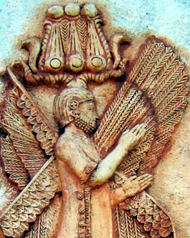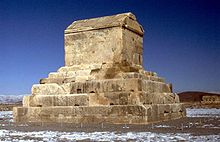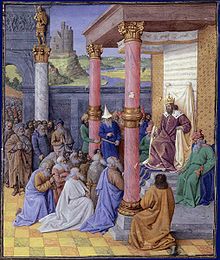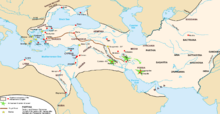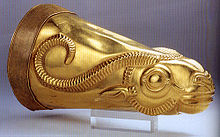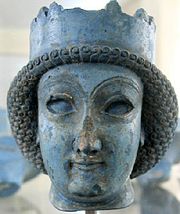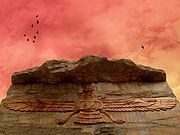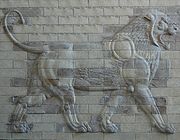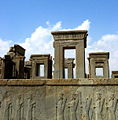- Achaemenid Empire
-
"Persian Empire" redirects here. For other uses, see Persian Empire (disambiguation).
Persian Empire ← 
←
←
←
ca. 550 BCE–330 BCE  →
→Standard of Cyrus the Great
Achaemenid Empire around 500 BCE shortly before its greatest extent under Darius I (without the conquest of Punjab). Capital Pasargadae, Ecbatana, Persepolis, Susa, Babylon Language(s) Old Persian (official and native language)
Imperial Aramaic(lingua franca)[1]
Elamite
Akkadian[2]Religion Zoroastrianism Government Monarchy King - 559–529 BCE (first) Cyrus the Great - 336–330 BCE (last) Darius III Historical era Ancient - Established 550 BCE - Construction starts at Persepolis 515 BCE - Conquest of Egypt by Cambyses II 525 BCE - Greco-Persian Wars 498–448 BCE - Conquered during Wars of Alexander the Great 330 BCE - Darius III is killed by Bessus 330 BCE Currency Daric and Siglos Today part of History of Iran
see also Kings of Persia · Timeline of IranAntiquity Prehistory Proto-Elamite period 3200–2800 Elamite dynasty 2800–550 Kassites 16th–12th cent. Mannaeans 10th–7th cent. Median Empire 728–550 Achaemenid Empire 550–330 Seleucid Empire 330–150 Parthian Empire 248 BCE–226 CE Sassanid Empire 226–651 Middle Ages Islamic conquest 637–651 Umayyad Caliphate 661–750 Abbasid Caliphate 750–1258 Tahirid dynasty 821–873 Alavid dynasty 864–928 Sajid dynasty 889/890–929 Saffarid dynasty 861–1003 Samanid dynasty 875–999 Ziyarid dynasty 928–1043 Buyid dynasty 934–1062 Sallarid 942–979 Ma'munids 995-1017 Ghaznavid Empire 963–1187 Ghori dynasty 1149–1212 Seljuq dynasty 1037–1194 Khwarezmid dynasty 1077–1231 Ilkhanate 1256–1353 Muzaffarid dynasty 1314–1393 Chupanid dynasty 1337–1357 Sarbadars 1337–1376 Jalayerid dynasty 1339–1432 Timurid dynasty 1370–1506 Qara Qoyunlu 1407–1468 Aq Qoyunlu 1378–1508 Modern history Safavid dynasty 1501–1722/36 Hotaki dynasty 1722–1729 Afsharid dynasty 1736–1750 Zand dynasty 1750–1794 Qajar dynasty 1781–1925 Pahlavi dynasty 1925–1979 Interim Government 1979–1980 Islamic Republic since 1980
edit The Persian Empire (Old Persian Parsa) (c. 550–330 BCE), sometimes known as the first Persian Empire and/or Achaemenid Empire, was founded in the 6th century BCE by Cyrus the Great who overthrew the Median confederation. It expanded to eventually rule over significant portions of the ancient world which at around 500 BCE stretched from the Indus Valley in the east, to Thrace and Macedon on the northeastern border of Greece.[4] The Achaemenid Empire would eventually control Egypt as well. It was ruled by a series of monarchs who unified its disparate tribes and nationalities by constructing a complex network of roads.
Calling themselves the Parsa after their original Aryan tribal name Parsua, Persians settled in a land west of Lake Urmia which they named Parsua, bounded on the west by the Tigris River and on the south by the Persian Gulf. This became their heartland for the duration of the Achaemenid Empire.[4] It was from this region that eventually Cyrus the Great (Cyrus II of Persia) would advance to defeat the Median, the Lydian, and the Babylonian Empires, opening the way for subsequent conquests into Egypt and Asia minor.
At the height of its power after the conquest of Egypt, the empire encompassed approximately 8 million km2[5] spanning three continents: Asia, Africa and Europe. At its greatest extent, the empire included the modern territories of Iran, Turkey, parts of Central Asia, Pakistan, Thrace and Macedonia, much of the Black Sea coastal regions, Afghanistan, Iraq, northern Saudi Arabia, Jordan, Israel, Lebanon, Syria, and all significant population centers of ancient Egypt as far west as Libya. It is noted in Western history as the antagonist foe of the Greek city states[4] during the Greco-Persian Wars, for emancipation of slaves including the Jewish people from their Babylonian captivity, and for instituting infrastructures such as a postal system, road systems, and the usage of an official language throughout its territories. The empire had a centralised, bureaucratic administration under the Emperor and a large professional army and civil services, inspiring similar developments in later empires.[6]
Contrary to popular belief, the vast size of the Persian empire, and its extraordinary ethnocultural diversity across its realm,[7] would not prove to be its undoing. The traditional argument is that the delegation of power to local governments eventually weakened the king's central authority, causing much energy and resources to be wasted in attempts to subdue local rebellions and[4] this was the reason why when Alexander the Great(Alexander III of Macedon) invaded Persia in 334 BCE he was faced by a disunified realm under a weak monarch, ripe for destruction.
This viewpoint has been challenged by specialists in the Achaemenid field such as Pierre Briant, David Stronach and Josef Wiesehöfer. Examination of the evidence demonstrates that the Achaemenid Empire was not facing any such crisis around the time of Alexander, and that only internal succession struggles within the Achaemenid family ever came close to weakening the Empire.[4] Alexander, an avid admirer of Cyrus the Great,[8] would eventually cause the collapse of the empire and its disintegration around 330 BCE into what later became the Ptolemaic Kingdom and Seleucid Empire, in addition to other minor territories which gained independence at that time. The Iranian Culture of the central plateau, however, continued to thrive and eventually reclaimed power by the 2nd century BCE.[4]
The historical mark of the Achaemenid Empire went far beyond its territorial and military influences and included cultural, social, technological and religious influences as well. Many Athenians adopted Achaemenid customs in their daily lives in a reciprocal cultural exchange,[9] some being employed by, or allied to the Persian kings. The impact of Cyrus the Great's Edict of Restoration is mentioned in Judeo-Christian texts and the empire was instrumental in the spread of Zoroastrianism as far east as China. Even Alexander the Great, the man who would set out to conquer this vast empire, would respect its customs, by enforcing respect for the royal Persian kings including Cyrus the Great, and even by appearing in proskynesis, a Persian royal custom, despite stern Macedonian disapproval.[10][11] The Persian empire would also set the tone for the politics, heritage and history of modern Persia (now called Iran).[12] The influence also encompasses Persia's previous territories collectively referred to as the Greater Persia. A notable engineering achievement is the Qanat water management system, the oldest and longest of which is older than 3000 years and longer than 44 miles (71 km.)[13]
In the 5th century BCE, it is estimated that 50 million or around 20%[14] of the world population lived in the Achaemenid Empire.[15]
Contents
History
Origin
"The Persian nation contains a number of tribes as listed here. [...]: the Pasargadae, Maraphii, and Maspii, upon which all the other tribes are dependent. Of these, the Pasargadae are the most distinguished; they contain the clan of the Achaemenids from which spring the Perseid kings. Other tribes are the Panthialaei, Derusiaei, Germanii, all of which are attached to the soil, the remainder -the Dai, Mardi, Dropici, Sagarti, being nomadic."
- [Herodotus, Histories 1.101 & 125]
The Persian Empire is named after an Indo-european tribe called Parsua. The name Persia is a Latin pronounciation of the Indo-Iranian people Parsua who named their territorial borders Persis, after their tribal name, an area located north of the Persian Gulf and East of Tigris river referred to as Persis (or in Persian, Pars).[16] Despite its success and rapid expansion, Achaemenid empire was not the first Iranian empire, as by sixth century BCE another group of ancient Iranians had already established the Median Empire.[16] The term Achaemenid is in fact the Latinized version of the Old Persian name Haxāmaniš (a bahuvrihi compound translating to "having a friend's mind"[17]), meaning in Greek "of the family of the Achaemenis." Despite the derivation of the name, Achaemenes was himself a minor seventh century ruler of the Anshan (Ansham or Anšān) located in southwestern Iran.[16] It was not until the time of Cyrus the Great (Cyrus II of Persia) a descendant of Achaemenes, that the Achaemenid empire developed the prestige of an empire, and set out to incorporate the existing empires of the ancient east, to become the vast Persian empire of which the ancient texts speak. At some point in 550 BCE, Cyrus the Great rose in rebellion against the Median empire (most likely due to the Medes' mismanagement of Persis), eventually conquering the Medes and creating the first Persian empire. Cyrus the Great would utilize his tactical genius,[18] as well as his understanding of the socio-political equations governing his territories, to eventually incorporate into the Persian empire the neighbouring Lydian and Neo-Babylonian empires, and also leading the way for his successor, Cambyses II to venture into Egypt and defeat the Hittite Empire and the Egyptian Kingdom. Cyrus the Great would reflect his political acumen in the management of his newly formed empire, as the Persian empire became the first to attempt to govern many different ethnic groups, on the principle of equal responsibilities, and rights for all people, so long as subjects paid their taxes and kept the peace.[19] Additionally, the king would agree not to interfere with the local customs, religions, and trades of its subject states,[19] a unique quality that eventually won Cyrus the support of the Babylonians. This system of management would ultimately become an issue for the Persians, as with a larger empire came the need for order and control, leading to expenditure of resources and mobilization of troops, to quell local rebellions, weakening the central power of the king. By the time of Darius III, this disorganization had almost led to a disunified realm.[4] The Persians from whom Cyrus hailed were originally nomadic, pastoral people in the western Iranian plateau and by 850 BCE were calling themselves the Parsa and their constantly shifting territory Parsua for the most part localized around Persis (Pars).[4] As Persians gained power, they developed the infrastructure to support their growing influence including creation of a capital named Pasargadae, and an opulent city named Persepolis. Begun during the rule of Darius the Great (Darius I), and completed some 100 years later,[20] Persepolis was a symbol of the empire serving both as a ceremonial centre and a center for government.[20] It had a special set of gradually progressive stairways named "All Countries"[20] around which carved relief decoration depicted scenes of heroism, hunting, natural themes, and presentation of the gifts to the Achaemenid kings by their subjects during the spring festival, Nowruz. The core structure was composed of a multitude of square rooms or halls, the biggest of which was called Apadana.[20] Tall, erect, decorated columns would often welcome visitors as well as impress them as to the size of the structure. Later on, Darius the Great (Darius I), would also utilize Susa and Ecbatana as his governmental centres, developing them into a similar metropolis status. Account of the ancestral lineage of the Persian kings of the Achaemenid dynasty can be derived from either documented Greek or Roman accounts, or from existing documented Persian accounts, such as those found in the behistun Inscription. However, since most existing accounts of this vast empire are in works of Greek philosophers and historians, and since much of the original Persian documents are lost, not to mention varying scholarly views on their origin and possible motivations behind them, it is difficult to create a definitive and completely objective list. Nonetheless, it is clear that Cyrus the Great (Cyrus II of Persia), and Darius the Great (Darius I of Persia), were critical in expansion of the empire. Cyrus the Great is often believed to be the son of Cambyses I, grandson of Cyrus I, father of Cambyses II, and a relative of Darius the Great, through a shared ancestor, Teispes. Cyrus the Great is also believed to have been a family member (possibly grandson) of the Median king Astyages through his mother, Mandana of Media. A minority of scholars argue that perhaps Achaemenes was a retrograde creation of Darius the Great, in order to reconcile his connection with Cyrus the Great, after gaining power.[16] Ancient Greek writers provide some legendary information about Achaemenes by calling his tribe the Pasargadae, and stating that he was "raised by an eagle". Plato, when writing about the Persians, identified Achaemenes with Perses, ancestor of the Persians in Greek mythology.[21] According to Plato, Achaemenes was the same person as Perses, a son of the Ethiopian queen Andromeda and the Greek hero Perseus, and a grandson of Zeus. Later writers believed that Achaemenes and Perses were different people, and that Perses was an ancestor of the king.[22] This account further confirms that Achaemenes could well have been a significiant Anshan leader and an ancestor of Cyrus the Great. Regardless, both Cyrus the Great and Darius the Great were related, prominent kings of Persia, under whose rule the empire expanded to include much of the ancient world.
Formation and expansion
Further information: Battle of the Persian Border, Persian Revolt, Battle of Pteria, Battle of Opis, and Battle of Pelusium (525 BC)The empire took its unified form with a central administration around Pasargadae erected by Cyrus the Great. The empire ended up conquering and enlarging the Median empire to include in addition Egypt and Asia Minor. During the reigns of Darius I and his son Xerxes I it engaged in military conflict with some of the major city-states of Ancient Greece, and although it came close to defeating the Greek army this war ultimately led to the empire's overthrow.[23]
In 559 BCE, Cambyses I the Elder was succeeded as the king of Anšān by his son Cyrus II the Great, who also succeeded the still-living Arsames as the King of Persia, thus reuniting the two realms. Cyrus is considered to be the first true king of the Persian empire, as his predecessors were subservient to the Medes. Cyrus the Great conquered Media, Lydia, and Babylon. Cyrus was politically shrewd, modeling himself as the "savior" of conquered nations, often allowing displaced people to return, and giving his subjects freedom to practice local customs. To reinforce this image, he instituted policies of religious freedom, and restored temples and other infrastructure in the newly acquired cities.(Most notably the Jewish inhabitants of Babylon, as recorded in the Cyrus Cylinder and the Tanakh). As a result of his tolerant policies he came to be known by those of the Jewish faith, as "the anointed of the Lord."[24][25]
His immediate successors were less successful. Cyrus' son Cambyses II conquered Egypt in 525 BCE, but died in July 522 BCE as the result of an injurious self-accident,[26] during a revolt led by a sacerdotal clan that had lost its power following Cyrus' conquest of Media. According to Herodotus, Cambyses II had originally ventured into Egypt to take revenge for the pharaoh Amasis's trickery when he sent a fake Egyptian bride whose family Amasis had murdered,[27] instead of his own daughter, to wed Cambyses II. Additionally negative reports of mistreatment caused by Amasis, given by Phanes of Halicarnassus, a wise council man serving Amasis, further enforced Cambyses's resolve to venture into Egypt. Amasis died before Cambyses II could face him, but his successor Psamtik III was defeated by Cambyses II in the Battle of Pelusium.
While Cambyses II was in Egypt, the Zoroastrian priests, whom Herodotus called Magi, usurped the throne for one of their own, Gaumata, who then pretended to be Cambyses II's younger brother Bardiya (Greek: Smerdis or Tanaoxares/Tanyoxarkes[26]), who had been assassinated some three years earlier. Owing to the strict rule of Cambyses II, especially his stance on taxation,[28] and his long absence in Egypt, "the whole people, Perses, Medes and all the other nations," acknowledged the usurper, especially as he granted a remission of taxes for three years (Herodotus iii. 68). Cambyses II himself would not be able to quell the imposters, as he died due to accidental injury on the way back from Egypt.
The claim that Gaumata had impersonated Bardiya (Smerdis), is derived from Darius the Great and the records at the Behistun Inscription. Historians are divided over the possibility that the story of the impostor was invented by Darius as justification for his coup.[29] Darius made a similar claim when he later captured Babylon, announcing that the Babylonian king was not, in fact, Nebuchadnezzar III, but an impostor named Nidintu-bel.[30]
According to the Behistun Inscription, Gaumata ruled for seven months before being overthrown in 522 BCE by Darius the Great (Darius I) (Old Persian Dāryavuš "Who Holds Firm the Good", also known as Darayarahush or Darius the Great). The Magi, though persecuted, continued to exist, and a year following the death of the first pseudo-Smerdis (Gaumata), saw a second pseudo-Smerdis (named Vahyazdāta) attempt a coup. The coup, though initially successful, failed.[31]
Herodotus writes[32] that the native leadership debated the best form of government for the Empire. It was agreed that an oligarchy would divide them against one another, and democracy would bring about mob rule resulting in a charismatic leader resuming the monarchy. Therefore, they decided a new monarch was in order, particularly since they were in a position to choose him. Darius I was chosen monarch from among the leaders. He was cousin to Cambyses II and Bardiya (Smerdis), claiming Ariaramnes as his ancestor.
The Achaemenids thereafter consolidated areas firmly under their control. It was Cyrus the Great and Darius the Great who, by sound and farsighted administrative planning, brilliant military maneuvering, and a humanistic world view, established the greatness of the Achaemenids and, in less than thirty years, raised them from an obscure tribe to a world power. It was during the reign of Darius the Great (Darius I) that Persepolis was built (518–516 BCE) and which would serve as capital for several generations of Achaemenid kings. Ecbatana (Hagmatāna "City of Gatherings", modern: Hamadan) in Media was greatly expanded during this period and served as the summer capital.
Darius the Great (Darius I) eventually attacked the Greek mainland, which had supported rebellious Greek colonies under his aegis; but as a result of his defeat at the Battle of Marathon, he was forced to pull the limits of his empire back to Asia Minor. Some scholars argue that in the context of history of the Near and Middle east in the first millennium, Alexander can be considered as the "last of the Achaemenids."[33] This is partly because Alexander maintained more or less the same political structure, and borders as the previous Achaemenid kings.
Greco-Persian Wars
Main article: Greco-Persian WarsBy the 5th century BCE the kings of Persia ruled over territories roughly encompassing today's Iran, Iraq, Armenia, Azerbaijan, Pakistan, Afghanistan, Tajikistan, Turkmenistan, Kyrgyzstan, Georgia, Macedonia, Uzbekistan, Turkey, Bulgaria, Cyprus, Kuwait, Egypt, Syria, Jordan, Israel, Lebanon, many parts of Greece, Libya and northern parts of Arabia.
The Ionian Revolt in 499 BCE, and associated revolts in Aeolis, Doris, Cyprus and Caria, were military rebellions by several regions of Asia Minor against Persian rule, lasting from 499 to 493 BCE At the heart of the rebellion was the dissatisfaction of the Greek cities of Asia Minor with the tyrants appointed by Persia to rule them, along with the individual actions of two Milesian tyrants, Histiaeus and Aristagoras. In 499 BCE, the then tyrant of Miletus, Aristagoras, launched a joint expedition with the Persian satrap Artaphernes to conquer Naxos, in an attempt to bolster his position in Miletus (both financially and in terms of prestige). The mission was a debacle, and sensing his imminent removal as tyrant, Aristagoras chose to incite the whole of Ionia into rebellion against the Persian king Darius the Great.
The Persians continued to reduce the cities along the west coast that still held out against them, before finally imposing a peace settlement in 493 BCE on Ionia that was generally considered to be both just and fair. The Ionian Revolt constituted the first major conflict between Greece and the Achaemenid Empire, and as such represents the first phase of the Greco-Persian Wars. Asia Minor had been brought back into the Persian fold, but Darius had vowed to punish Athens and Eretria for their support for the revolt.[34] Moreover, seeing that the political situation in Greece posed a continued threat to the stability of his Empire, he decided to embark on the conquest of all of Greece. However, the Persian forces were defeated at the Battle of Marathon and Darius would die before having the chance to launch an invasion of Greece.
Xerxes I (485–465 BCE, Old Persian Xšayārša "Hero Among Kings"), son of Darius I, vowed to complete the job. He organized a massive invasion aiming to conquer Greece. His army entered Greece from the north, meeting little or no resistance through Macedonia and Thessaly, but was delayed by a small Greek force for three days at Thermopylae. A simultaneous naval battle at Artemisium was tactically indecisive as large storms destroyed ships from both sides. The battle was stopped prematurely when the Greeks received news of the defeat at Thermopylae and retreated. The battle was a strategic victory for the Persians, giving them uncontested control of Artemisium and the Aegean Sea.
Following his victory at the Battle of Thermopylae, Xerxes sacked the evacuated city of Athens and prepared to meet the Greeks at the strategic Isthmus of Corinth and the Saronic Gulf. In 480 BCE the Greeks won a decisive victory at the Battle of Salamis and forced Xerxes to retire to Sardis. The army which he left in Greece under Mardonius retook Athens but was eventually destroyed in 479 BCE at the Battle of Plataea. The final defeat of the Persians at Mycale encouraged the Greek cities of Asia to revolt, and marked the end of Persian expansion into Europe.
The cultural phase
Xerxes I was followed by Artaxerxes I (465–424 BCE), who moved the capital from Persepolis to Babylon. It was during this reign that Elamite ceased to be the language of government, and Aramaic gained in importance. It was probably during this reign that the solar calendar was introduced as the national calendar. Under Artaxerxes I, Zoroastrianism became the de-facto religion of state, and for this Artaxerxes I is today also known as the Constantine of that faith.
Artaxerxes I died in Susa, and his body was brought to Persepolis for internment in the tomb of his forebears. Artaxerxes I was immediately succeeded by his eldest son Xerxes II, who was however assassinated by one of his half-brothers a few weeks later. Darius II rallied support for himself and marched eastwards, executing the assassin and was crowned in his stead.
From 412 Darius II (423–404 BCE), at the insistence of the able Tissaphernes, gave support first to Athens, then to Sparta, but in 407 BCE, Darius' son Cyrus the Younger was appointed to replace Tissaphernes and aid was given entirely to Sparta which finally defeated Athens in 404 BCE In the same year, Darius fell ill and died in Babylon. At his deathbed, his Babylonian wife Parysatis pleaded with Darius to have her second eldest son Cyrus (the Younger) crowned, but Darius refused.
Darius was then succeeded by his eldest son Artaxerxes II Memnon. Plutarch relates (probably on the authority of Ctesias) that the displaced Tissaphernes came to the new king on his coronation day to warn him that his younger brother Cyrus (the Younger) was preparing to assassinate him during the ceremony. Artaxerxes had Cyrus arrested and would have had him executed if their mother Parysatis had not intervened. Cyrus was then sent back as Satrap of Lydia, where he prepared an armed rebellion. Cyrus and Artaxerxes met in the Battle of Cunaxa in 401 BCE, where Cyrus was killed.
Artaxerxes II (404–358 BCE), was the longest reigning of the Achaemenid kings and it was during this 45-year period of relative peace and stability that many of the monuments of the era were constructed. Artaxerxes moved the capital back to Persepolis, which he greatly extended. Also the summer capital at Ecbatana was lavishly extended with gilded columns and roof tiles of silver and copper (Polybius, 27 October 2012). The extraordinary innovation of the Zoroastrian shrine cults can also be dated to his reign, and it was probably during this period that Zoroastrianism was disseminated throughout Asia Minor and the Levant, from Armenia. The temples, though serving a religious purpose, were however not a purely selfless act: they also served as an important source of income. From the Babylonian kings, the Achaemenids had taken over the concept of a mandatory temple tax, a one-tenth tithe which all inhabitants paid to the temple nearest to their land or other source of income (Dandamaev & Lukonin, 1989:361–362). A share of this income called the quppu ša šarri, "kings chest"—an ingenious institution originally introduced by Nabonidus—was then turned over to the ruler. In retrospect, Artaxerxes is generally regarded as an amiable man who lacked the moral fibre to be a really successful ruler. However, six centuries later Ardeshir I, founder of the second Persian Empire, would consider himself Artaxerxes' successor, a grand testimony to the importance of Artaxerxes to the Persian psyche.
Fall of the empire
 The Battle of Issus, between Alexander the Great on horseback to the left, and Darius III in the chariot to the right, represented in a Pompeii mosaic dated 1st century BCE – National Museum of Archaeology in Naples.
The Battle of Issus, between Alexander the Great on horseback to the left, and Darius III in the chariot to the right, represented in a Pompeii mosaic dated 1st century BCE – National Museum of Archaeology in Naples.
According to Plutarch, Artaxerxes' successor Artaxerxes III (358 – 338 BCE) came to the throne by bloody means, ensuring his place upon the throne by the assassination of eight of his half-brothers.[35] In 343 BCE Artaxerxes III defeated Nectanebo II, driving him from Egypt, and made Egypt once again a Persian satrapy. In 338 BCE Artaxerxes III died under unclear circumstances (natural causes according to cuneiform sources but Diodorus, a Greek historian, reports that Artaxerxes was murdered by Bagoas, his minister).[36] while Philip of Macedon united the Greek states by force and began to plan an invasion into the empire.
Artaxerxes III was succeeded by Artaxerxes IV Arses, who before he could act was also poisoned by Bagoas. Bagoas is further said to have killed not only all Arses' children, but many of the other princes of the land. Bagoas then placed Darius III (336–330 BCE), a nephew of Artaxerxes IV, on the throne. Darius III, previously Satrap of Armenia, personally forced Bagoas to swallow poison. In 334 BCE, when Darius was just succeeding in subduing Egypt again, Alexander and his battle-hardened troops invaded Asia Minor.
At two different times, the Achaemenids ruled Egypt although the Egyptians twice regained temporary independence from Persia. After the practice of Manetho, Egyptian historians refer to the periods in Egypt when the Achaemenid dynasty ruled as the twenty-seventh dynasty of Egypt, 525–404 BCE, until the death of Darius II, and the thirty-first dynasty of Egypt, 343–332 BCE, which began after Nectanebo II was defeated by the Persian king Artaxerxes III.
Alexander the Great (Alexander III of Macedon) defeated the Persian armies at Granicus (334 BCE), followed by Issus (333 BCE), and lastly at Gaugamela (331 BCE). Afterwards, he marched on Susa and Persepolis which surrendered in early 330 BCE From Persepolis, Alexander headed north to Pasargadae where he visited the tomb of Cyrus, the burial of the man whom he had heard of from Cyropedia.
In the ensuing chaos created by Alexander the Great's invasion of Persia, Cyrus the Great's tomb was broken into and most of its luxuries were looted. When Alexander the Great reached the tomb, he was horrified by the manner in which the tomb was treated, and questioned the Magi, putting them to court.[37][38] On some accounts, Alexander's decision to put the Magi on trial was more about his attempt to undermine their influence and his show of power in his newly conquered empire, than a concern for Cyrus's tomb.[39] Regardless, Alexander the Great ordered Aristobulus to improve the tomb's condition and restore its interior, showing respect for Cyrus.[37] From there he headed to Ecbatana, where Darius III had sought refuge.
Darius III was taken prisoner by Bessus, his Bactrian satrap and kinsman. As Alexander approached, Bessus had his men murder Darius III and then declared himself Darius' successor, as Artaxerxes V, before retreating into Central Asia leaving Darius' body in the road to delay Alexander, who brought it to Persepolis for an honorable funeral. Bessus would then create a coalition of his forces, in order to create an army to defend against Alexander. Before Bessus could fully unite with his confederates at the eastern part of the empire,[40] Alexander, fearing the danger of Bessus gaining control, found him, put him on trial in a Persian court under his control, and ordered his execution in a cruel and barbarous manner.[41]
Despite having succeeded to conquer the whole of the Persian empire, Alexander the Great, was nonetheless unable to offer a stable alternative.[42] After his death, Alexander's once massive Persian empire was broken into and succeeded by few smaller empires the most significant of which was the Seleucid Empire, ruled by the generals of Alexander and their descendants. They in turn would be succeeded by the Parthian Empire.
Istakhr, one of the vassal kingdoms of the Parthian Empire, would be overthrown by Papak, a priest of the temple there. Papak's son, Ardašir I, who named himself in remembrance of Artaxerxes II, would revolt against the Parthians, eventually defeating them and establishing the Sassanid Empire or as it is known the second Persian Empire.
Descendants in later Iranian dynasties
Both the later dynasties of the Parthians and Sassanids and Gabaris would on occasion claim Achaemenid descent. Recently there has been some corroboration for the Parthian claim to Achaemenid ancestry via the possibility of an inherited disease (neurofibromatosis) demonstrated by the physical descriptions of rulers and from evidence of familial disease on ancient coinage.[43]
Government
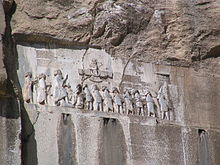 The Behistun Inscription tells the story of Darius the Great's conquests, with the names of twenty-three satrapys subject to him.
The Behistun Inscription tells the story of Darius the Great's conquests, with the names of twenty-three satrapys subject to him.
Cyrus the Great founded the empire as a multi-state empire, governed by four capital states; Pasargadae, Babylon, Susa and Ekbatana. The Achaemenids allowed a certain amount of regional autonomy in the form of the satrapy system. A satrapy was an administrative unit, usually organized on a geographical basis. A 'satrap' (governor) was the vassal king, who administered the region, a 'general' supervised military recruitment and ensured order, and a 'state secretary' kept the official records. The general and the state secretary reported directly to the satrap as well as the central government. At differing times, there were between 20 and 30 satrapies.[44]
Cyrus the Great created an organized army including the Immortals unit, consisting of 10,000 highly trained soldiers[45] Cyrus also formed an innovative postal system throughout the empire, based on several relay stations called Chapar Khaneh.[46]
Darius the Great moved the capital from Pasargadae to Persepolis;[47] he revolutionized the economy by placing it on a silver and gold coinage and introducing a regulated and sustainable tax system that was precisely tailored to each satrapy, based on their supposed productivity and their economic potential. For instance, Babylon was assessed for the highest amount and for a startling mixture of commodities – 1000 silver talents, four months supply of food for the army. India was clearly already fabled for its gold; the province (consisting of the sindh and western punjab regions of ancient northwestern India) was to supply gold dust equal in value to the very large amount of 4680 silver talents. Egypt was known for the wealth of its crops; it was to be the granary of the Persian Empire (as later of Rome's) and was required to provide 120,000 measures of grain in addition to 700 talents of silver. This was exclusively a tax levied on subject peoples.[48] Other accomplishments of Darius' reign included codification of the data, a universal legal system, and construction of a new capital at Persepolis.
Under the Achaemenids, the trade was extensive and there was an efficient infrastructure that facilitated the exchange of commodities in the far reaches of the empire. Tariffs on trade were one of the empire's main sources of revenue, along with agriculture and tribute.[48][49]
The satrapies were linked by a 2,500-kilometer highway, the most impressive stretch being the Royal Road from Susa to Sardis, built by command of Darius I. The relays of mounted couriers could reach the remotest of areas in fifteen days. Despite the relative local independence afforded by the satrapy system, royal inspectors, the "eyes and ears of the king", toured the empire and reported on local conditions. The king also maintained a personal bodyguard of the elite 10,000 Immortals when not at war.
The practice of slavery in Achaemenid Persia was generally banned, although there is evidence that conquered and/or rebellious armies were sold into captivity.[50] Zoroastrianism, the de facto religion of the empire, explicitly forbids slavery,[51] and the kings of Achaemenid Persia, especially the founder Cyrus the Great, followed this ban to varying degrees, as evidenced by the freeing of the Jews at Babylon, and the construction of Persepolis by paid workers.
The vexilloid of the Achaemenid Empire was a gold falcon on a field of crimson.[52][53]
Provinces of the Achaemenid Empire (Behistun, Persepolis, Naqsh-e Rustam, Susa, Susa foundation charter, and Daiva inscriptions)Across the sea · Akaufaka · Arabia · Arachosia · Aria · Armenia · Assyria · Babylonia · Bactria · Cappadocia · Caria · Chorasmia · Dahae · Drangiana · 1t Egyptian Satrapy / 2nd Egyptian Satrapy · Eber-Nari · Elam · Gandhara · Gedrosia · Hyrcania · Ionia · Indus · Kush · Libya · Maka · Media · Parthia · Persia · Quadia · Saka · Sardis · Sattagydia · Skudra · Sogdia · Yehud See also Districts of the Achaemenid Empire
See also Districts of the Achaemenid Empire
according to HerodotusMilitary
Despite its humble origins in Persis, the empire reached an enormous size under the leadership of Cyrus the Great. Cyrus created a multi-state empire where he allowed regional rulers, called the 'satrap' to rule as his proxy over a certain designated area of his empire called the satrapy. The basic rule of governance was based upon loyalty and obedience of each satrapy to the central power, or the king, and compliance with tax laws.[19] Due to the ethnocultural diversity of the subject nations under the rule of Persia, its enormous geographic size, and the constant struggle for power by regional competitors,[4] the creation of a professional army was necessary for both maintenance of the peace, and also to enforce the authority of the king in cases of rebellion and foreign threat.[6][45] Cyrus managed to create a strong land army, using it to advance in his campaigns in Babylonia, Lydia, and Asia Minor, which after his death was used by his son Cambyses II, in Egypt against Psamtik III. Cyrus would die battling a local Iranian insurgency in the empire, before he could have a chance to develop a naval force.[54] That task however would fall to Darius the Great, who would officially give Persians their own royal navy to allow them to engage their enemies on multiple seas of this vast empire, from the Black sea, and the Aegean Sea, to the Persian Gulf, Ionian Sea, and the Mediterranean sea.
Since its foundation by Cyrus, the Persian empire had been primarily a land empire with a strong army, but void of any actual naval forces. By the fifth century BCE, this was to change, as the empire came across Greek, and Egyptian forces, each with their own maritime traditions and capabilities. Darius the Great (Darius I) is to be credited as the first Achaemenid king to invest in a Persian fleet.[55] Even by then no true "imperial navy" had existed either in Greece or Egypt. Persia would become the first empire, under Darius, to inaugurate and deploy the first regular imperial navy.[55] Despite this achievement, the personnel for the imperial navy would not come from Iran, but were often Phoenicians (mostly from Sidon), Egyptians, Cypriots, and Greeks chosen by Darius the Great to operate the empire's combat vessels.[55]
At first the ships were built in Sidon by the Phoenicians; the first Achaemenid ships measured about 40 meters in length and 6 meters in width, able to transport up to 300 Persian troops at any one trip. Despite origin of the technique of the arsenal and ship construction in Sidon, soon other states of the empire were constructing their own ships each incorporating slight local preferences. The ships eventually found their way to the Persian Gulf.[55] Persian naval forces laid the foundation for a strong Persian maritime presence in the Persian Gulf, that existed until the arrival of the British East India Company, and the Royal Navy in the mid-nineteenth century CE. Persians were not only stationed on islands of the Persian Gulf, but also had ships often of 100 to 200 capacity patrolling the empire's various rivers including Shatt-al-Arab, Tigris, and the Nile in the west, as well as Sind waterway in India.[55]
The Achaemenid high naval command had established major naval bases located along Shatt al-Arab river, Bahrain, Oman, and Yemen. The Persian fleet would soon not only be used for peace-keeping purposes along the Shatt al-Arab but would also open the door to trade with India via the Persian Gulf.[55] Darius's navy was in many ways a world power at the time, but it would be Artaxerxes II who in the summer of 397 B.C.E would build a formidable navy, as part of a rearmament which would lead to his decisive victory at Knidos in 394 BCE, reestablishing Achaemenid power in Ionia. Artaxerxes II would also utilize his massive navy to later on quell a rebellion in Egypt.[56]
The construction material of choice was wood, but some armored Achaemenid ships had metallic blades on the front, often meant to slice enemy ships using the ship's momentum. Naval ships were also equpied with hooks on the side to grab enemy ships, or to negotiate their position. The ships were propelled by sails or manpower. As far as maritime engagement, the ships were equipped with two mangonels that would launch projectiles such as stones, or flammable substances.[55]
Xenophon describes his eye-witness account of a massive military bridge created by joining 37 Persian ships across the Tigris river. The Persians utilized each boat's buoyancy, in order to support a connected bridge above which supply could be transferred.[55] Herodotus also gives many accounts of Persians utilizing ships to build bridges.[57][58] Darius the Great, in an attempt to subdue the Scythian horsemen north of the Black sea, crossed over at the Bosphorus, using an enormous bridge made by connecting Achaemenid boats, then marched up to the Danube, crossing it by means of a second boat bridge.[59] The bridge over the Bosphorus essentially connected the nearest tip of Asia to Europe, encompasing at least some 1000 meters of open water if not more. Herodotus describes the spectacle, and calls it the "bridge of Darius":[60]
- "Strait called Bosphorus, across which the bridge of Darius had been thrown is hundred and twenty furlongs in length, reaching from the Euxine, to the Propontis. The Propontis is five hundred furlongs across, and fourteen hundred long. Its waters flow into the Hellespont, the length of which is four hundred furlongs..."
Years later, a similar boat bridge would be constructed by Xerxes the Great (Xerxes I), in his invasion of Greece. Although the Persians failed to capture the Greek city states completely, the tradition of maritime involvement was carried down by the Persian kings, most notably Artaxerxes II. Years later, when Alexander invaded Persia and during his advancement into India, he took a page from the Persian art of war, by having Hephaestion and Perdiccas construct a similar boat-bridge at the Indus river, in India in spring of 327 BCE[61]
Culture
 The ruins of Tachar palace located in Persepolis
The ruins of Tachar palace located in Persepolis
Herodotus, in his mid-5th century BCE account of Persian residents of the Pontus, reports that Persian youths, from their fifth year to their twentieth year, were instructed in three things – to ride a horse, to draw a bow, and to speak the Truth.[62]
He further notes that:[62]
- the most disgraceful thing in the world [the Persians] think, is to tell a lie; the next worst, to owe a debt: because, among other reasons, the debtor is obliged to tell lies.
In Achaemenid Persia, the lie, druj, is considered to be a cardinal sin, and it was punishable by death in some extreme cases. Tablets discovered by archaeologists in the 1930s[63] at the site of Persepolis give us adequate evidence about the love and veneration for the culture of truth during the Achaemenian period. These tablets contain the names of ordinary Persians, mainly traders and warehouse-keepers.[64] According to Professor Stanley Insler of Yale University, as many as 72 names of officials and petty clerks found on these tablets contain the word truth.[65] Thus, says Insler, we have Artapana, protector of truth, Artakama, lover of truth, Artamanah, truth-minded, Artafarnah, possessing splendour of truth, Artazusta, delighting in truth, Artastuna, pillar of truth, Artafrida, prospering the truth and Artahunara, having nobility of truth. It was Darius the Great, who laid down the ordinance of good regulations during his reign. King Darius' testimony about his constant battle against the lie is found in cuneiform inscriptions. Carved high up in the Behistun mountain on the road to Kermanshah, Darius the Great (Darius I) testifies:[66]
- I was not a lie-follower, I was not a doer of wrong ... According to righteousness I conducted myself. Neither to the weak or to the powerful did I do wrong. The man who cooperated with my house, him I rewarded well; who so did injury, him I punished well.
Darius had his hands full dealing with large-scale rebellion which broke out throughout the empire. After fighting successfully with nine traitors in a year, Darius records his battles against them for posterity and tells us how it was the lie that made them rebel against the empire. At Behistun, Darius says:
- I smote them and took prisoner nine kings. One was Gaumata by name, a Magian; he lied; thus he said: I am Smerdis, the son of Cyrus...One, Acina by name, an Elamite; he lied; thus he said: I am king in Elam... One, Nidintu-Bel by name, a Babylonian; he lied; thus he said: I am Nebuchadnezzar, the son of Nabonidus. King Darius then tells us, The Lie made them rebellious, so that these men deceived the people.[67]
Then an advice to his son Xerxes, who is to succeed him as the great king:
- Thou who shalt be king hereafter, protect yourself vigorously from the Lie; the man who shall be a lie-follower, him do thou punish well, if thus thou shall think. May my country be secure!
Languages
During the reign of Cyrus and Darius, and as long as the seat of government was still at Susa in Elam, the language of the chancellory was Elamite. This is primarily attested in the Persepolis fortification and treasury tablets that reveal details of the day-to-day functioning of the empire.[64] In the grand rock-face inscriptions of the kings, the Elamite texts are always accompanied by Akkadian and Old Persian inscriptions, and it appears that in these cases, the Elamite texts are translations of the Old Persian ones. It is then likely that although Elamite was used by the capital government in Susa, it was not a standardized language of government everywhere in the empire. The use of Elamite is not attested after 458 BCE
Following the conquest of Mesopotamia, the Aramaic language (as used in that territory) was adopted as a "vehicle for written communication between the different regions of the vast empire with its different peoples and languages. The use of a single official language, which modern scholarship has dubbed Official Aramaic or Imperial Aramaic, can be assumed to have greatly contributed to the astonishing success of the Achaemenids in holding their far-flung empire together for as long as they did."[68] In 1955, Richard Frye questioned the classification of Imperial Aramaic as an "official language", noting that no surviving edict expressly and unambiguously accorded that status to any particular language.[69] Frye reclassifies Imperial Aramaic as the "lingua franca" of the Achaemenid territories, suggesting then that the Achaemenid-era use of Aramaic was more pervasive than generally thought. Many centuries after the fall of the empire, Aramaic script and – as ideograms – Aramaic vocabulary would survive as the essential characteristics of the Pahlavi writing system.[70]
Although Old Persian also appears on some seals and art objects, that language is attested primarily in the Achaemenid inscriptions of Western Iran, suggesting then that Old Persian was the common language of that region. However, by the reign of Artaxerxes II, the grammar and orthography of the inscriptions was so "far from perfect"[71] that it has been suggested that the scribes who composed those texts had already largely forgotten the language, and had to rely on older inscriptions, which they to a great extent reproduced verbatim.[72]
Customs
Herodotus mentions that the Persians were given to great birthday feasts (Herodotus, Histories 8), which would be followed by many desserts, a treat which they reproached the Greeks for omitting from their meals. He also observed that the Persians drank wine in large quantities and used it even for counsel, deliberating on important affairs when drunk, and deciding the next day, when sober, whether to act on the decision or set it aside.
Religion
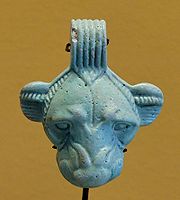 The image of a lioness used as a pendant, late sixth–fourth centuries BCE, from Susa – Department of Oriental Antiquities, Louvre.
The image of a lioness used as a pendant, late sixth–fourth centuries BCE, from Susa – Department of Oriental Antiquities, Louvre.
It was during the Achaemenid period that Zoroastrianism reached South-Western Iran, where it came to be accepted by the rulers and through them became a defining element of Persian culture. The religion was not only accompanied by a formalization of the concepts and divinities of the traditional Indo-Iranian pantheon but also introduced several novel ideas, including that of free will.[73][74]
Under the patronage of the Achaemenid kings, and by the 5th century BCE as the de-facto religion of the state, Zoroastrianism would reach all corners of the empire. The Bible claims that Cyrus the Great allowed the Jews to return to their homeland after centuries of captivity by the Assyrian and Babylonian empires.
During the reign of Artaxerxes I and Darius II, Herodotus wrote "[the Perses] have no images of the gods, no temples nor altars, and consider the use of them a sign of folly. This comes, I think, from their not believing the gods to have the same nature with men, as the Greeks imagine." He claims the Persians offer sacrifice to: "the sun and moon, to the earth, to fire, to water, and to the winds. These are the only gods whose worship has come down to them from ancient times. At a later period they began the worship of Urania, which they borrowed from the Arabians and Assyrians. Mylitta is the name by which the Assyrians know this goddess, to whom the Persians referred as Anahita." (The original name here is Mithra, which has since been explained to be a confusion of Anahita with Mithra, understandable since they were commonly worshipped together in one temple).
From the Babylonian scholar-priest Berosus, who—although writing over seventy years after the reign of Artaxerxes II Mnemon—records that the emperor had been the first to make cult statues of divinities and have them placed in temples in many of the major cities of the empire (Berosus, III.65). Berosus also substantiates Herodotus when he says the Persians knew of no images of gods until Artaxerxes II erected those images. On the means of sacrifice, Herodotus adds "they raise no altar, light no fire, pour no libations." This sentence has been interpreted to identify a critical (but later) accretion to Zoroastrianism. An altar with a wood-burning fire and the Yasna service at which libations are poured are all clearly identifiable with modern Zoroastrianism, but apparently, were practices that had not yet developed in the mid-5th century. Boyce also assigns that development to the reign of Artaxerxes II (4th century BCE), as an orthodox response to the innovation of the shrine cults.
Herodotus also observed that "no prayer or offering can be made without a magus present" but this should not be confused with what is today understood by the term magus, that is a magupat (modern Persian: mobed), a Zoroastrian priest. Nor does Herodotus' description of the term as one of the tribes or castes of the Medes necessarily imply that these magi were Medians. They simply were a hereditary priesthood to be found all over Western Iran and although (originally) not associated with any one specific religion, they were traditionally responsible for all ritual and religious services. Although the unequivocal identification of the magus with Zoroastrianism came later (Sassanid era, 3rd–7th century CE), it is from Herodotus' magus of the mid-5th century that Zoroastrianism was subject to doctrinal modifications that are today considered to be revocations of the original teachings of the prophet. Also, many of the ritual practices described in the Avesta's Vendidad (such as exposure of the dead) were already practiced by the magu of Herodotus ' time.
Art and architecture
Main article: Achaemenid architectureAchaemenid architecture refers to the architectural achievements of the Achaemenid Persians manifesting in construction of spectacular cities utilized for governance and inhabitation, temples made for worship and social gatherings (such as Zoroastrian temples), and mausoleums erected in honor of fallen kings (such as the burial tomb of Cyrus the Great). The quintessential feature of Persian architecture was its eclectic nature with elements of Median, Assyrian, and Asiatic Greek all incorporated, yet maintaining a unique Persian identity seen in the finished products.[75]
Achaemenid art refers to the artistic achievements of the Aachaemenid Persians manifesting in construction of complicated frieze reliefs, crafting of precious metals ( such as the Oxus Treasure), decoration of palaces, glazed brick masonry, fine craftsmanship (masonry, carpentry, etc.), and gardening, and out door decoration. It is critical to understand that although Persians borrowed techniques from all corners of their empire, it was not simply a combination of styles, but synthesis of a new unique Persian style.[76] Cyrus the Great in fact had an extensive ancient Iranian heritage behind him; the rich Achaemenid gold work, which inscriptions suggest may have been a specialty of the Medes, was for instance in the tradition of the delicate metalwork found in Iron Age II times at Hasanlu and still earlier at Marlik.
One of the most amazing examples of both Achaemenid architecture and art is the grand palace of Persepolis, and its detailed workmanship, coupled with its grand scale. In describing the construction of his palace at Susa, Darius the Great records that:
- "...yaka timber was brought from Gandara and from Carmania. The gold was brought from Sardis and from Bactria...the precious stone lapis-lazuli and carnelian...was brought from Sogdiana. The turquoise from Chorasmia, the silver and ebony from Egypt, the ornamentation from Ionia, the ivory from Ethiopia and from Sindh and from Arachosia. The stone-cutters who wrought the stone, those were Ionians and Sardians. The goldsmiths were Medes and Egyptians. The men who wrought the wood, those were Sardians and Egyptians. The men who wrought the baked brick, those were Babylonians. The men who adorned the wall, those were Medes and Egyptians."
This was imperial art on a scale the world had not seen before. Materials and artists were drawn from all corners of the empire, and thus tastes, styles, and motifs became mixed together in an eclectic art and architecture that in itself mirrored the Persian empire.
 Panoramic view of the Naqsh-e Rustam. This site contains the tombs of four Achaemenid kings, including those of Darius I and Xerxes.
Panoramic view of the Naqsh-e Rustam. This site contains the tombs of four Achaemenid kings, including those of Darius I and Xerxes.
Legacy
The Achaemenid Empire left a lasting impression on the heritage and the cultural identity of Asia and Middle East, as well as influencing the development and structure of future empires. In fact the Greeks and later on the Romans copied the best features of the Persian method of governing the empire, and vicariously adopted them.[77]
Georg W. F. Hegel in his work The Philosophy of History introduces the Persian Empire as the "first empire that passed away" and its people as the "first historical people" in history. According to his account;[78]
- The Persian Empire is an empire in the modern sense – like that which existed in Germany, and the great imperial realm under the sway of Napoleon; for we find it consisting of a number of states, which are indeed dependant, but which have retained their own individuality, their manners, and laws. The general enactments, binding upon all, did not infringe upon their political and social idiosyncrasies, but even protected and maintained them; so that each of the nations that constitute the whole, had its own form of constitution. As light illuminates everything – imparting to each object a peculiar vitality – so the Persian Empire extends over a multitude of nations, and leaves to each one its particular character. Some have even kings of their own; each one its distinct language, arms, way of life and customs. All this diversity coexists harmoniously under the impartial dominion of Light... a combination of peoples – leaving each of them free. Thereby, a stop is put to that barbarism and ferocity with which the nations had been wont to carry on their destructive feuds.
The famous American orientalist, Professor Arthur Upham Pope (1881–1969) said:[79] "The western world has a vast unpaid debt to the Persian Civilization!"
Will Durant, the American historian and philosopher, during one his speeches, "Persia in the History of Civilization", as an address before the Iran-America Society in Tehran on 21 April 1948, stated:[80]
- For thousands of years Persians have been creating beauty. Sixteen centuries before Christ there went from these regions or near it... You have been here a kind of watershed of civilization, pouring your blood and thought and art and religion eastward and westward into the world... I need not rehearse for you again the achievements of your Achaemenid period. Then for the first time in known history an empire almost as extensive as the United States received an orderly government, a competence of administration, a web of swift communications, a security of movement by men and goods on majestic roads, equaled before our time only by the zenith of Imperial Rome.
Achaemenid kings and rulers
Unattested
- The epigraphic evidence for these rulers cannot be confirmed and are often considered to have been invented by Darius I
- Ariaramnes of Persia, son of Teispes and co-ruler with Cyrus I
- Arsames of Persia, son of Ariaramnes and co-ruler with Cambyses I
Attested
Kings of Anshan King Reign (BCE) Consort(s) Comments Teispes of Anshan 7th Century son of Achaemenes, King of Anshan Cyrus I Late 7th / early 6th Century son of Teispes, King of Anshan Cambyses I of Anshan Early 6th Century Mandana of Media son of Cyrus I, King of Anshan Cyrus II the Great c.550-530 Cassandane of Persia son of Cambyses I and Mandana – conquered Media 550 BCE King of Media, Babylonia, Lydia, Persia, Anshan, and Sumer. Created the Achaemenid Persian Empire. Kings of Persia (529–359 BCE); Twenty-seventh dynasty of Egypt (525–399 BCE) King Reign (BCE) Consort(s) Comments Cambyses II 529-522 son of Cyrus the Great and Cassandane. Conquered dynasty of Egypt. Bardiya (Smerdis) 522 Phaedymia Son of Cyrus the Great. (Imposter Gaumata acted in his place) Darius I the Great 521-486 Atossa
Artystone
Parmys
Phratagunebrother-in-law of Smerdis (Bardiya), son of Hystapes, grandson of Arsames
Armies defeated at Battle of Marathon in Greece.Xerxes I the Great 485-465 Amestris son of Darius I and Atossa
Victorious at Battle of Thermopylae
Defeated at Battle of SalamisArtaxerxes I Longimanus 465-424 Damaspia
Cosmartidene
Alogyne
Andiason of Xerxes I and Amestris Xerxes II 424 son of Artaxerxes I and Damaspia Sogdianus 424-423 Son of Artaxerxes I and Alogyne; half-brother and rival of Xerxes II Darius II of Persia 423-405 Parysatis Son of Artaxerxes I and Cosmartidene; half-brother and rival of Xerxes II Artaxerxes II Mnemon 404-359 Stateira son of Darius II (see also Xenophon) Early in the reign of Artaxerxes II (in 399 BCE), the Persians lose control over Egypt. The Persians regain control 57 years later – in 342 BCE – when Artaxerxes III conquers Egypt.
Kings of Persia (358–330 BCE); Thirty-first dynasty of Egypt (342–332 BCE) King Reign (BCE) Consort(s) Comments Artaxerxes III Ochus 358-338 son of Artaxerxes II and Stateira Artaxerxes IV Arses 338-336 son of Artaxerxes III and Atossa Darius III 336-330 Stateira I great-grandson of Darius II
defeated by Alexander the GreatGallery
-
Silver rhyta used as a drinking vessels in Persia, representing a fanciful chimeric beast that is both mammal and bird.
-
Anatolian-Persian art ,Dascylium (capital of the Persian satraps of Phrygia, modern Ergili), 5th cent BCE, Istanbul Archaeology Museum.
See also
- List of kings of Persia
- Achaemenid family tree
- Purim, a Jewish festival related to the Achaemenid Empire
Notes
- ^ Josef Wiesehöfer, Ancient Persia, (I.B. Tauris Ltd, 2007), 119.
- ^ Harald Kittel, Juliane House, Brigitte Schultze (2007). Traduction: encyclopédie internationale de la recherche sur la traduction. Walter de Gruyter. pp. 1194–5. ISBN 9783110171457. http://books.google.com/?id=oD0dBqGDNscC&pg=PA1194&dq=Old+Persian+official+language+of+achaemenid+empire#v=onepage&q=Old%20Persian%20official%20language%20of%20achaemenid%20empire&f=false.
- ^ Security and Territoriality in the Persian Gulf: A Maritime Political Geography by Pirouz Mojtahed-Zadeh, page 119
- ^ a b c d e f g h i David Sacks, Oswyn Murray, Lisa R. Brody (2005). Encyclopedia of the ancient Greek world. Infobase Publishing. pp. 256 (at the right portion of the page). ISBN 9780816057221. http://books.google.com/?id=yyrao0dadqAC&pg=PA256&dq=perseus+father+of+persian#v=onepage&q=perseus%20father%20of%20persian&f=false.
- ^ Vasseghi, Sheda, "The other Iran story: Re-engineering the nation's cultural DNA", Breaking... WorldTribune.com World Tribune News, (12 October 2009).
- ^ a b Schmitt Achaemenid dynasty (i. The clan and dynasty)
- ^ Pierre Briant (2006). From Cyrus to Alexander: A History of the Persian Empire. Eisenbrauns. pp. 1–3. ISBN 9781575061207. http://books.google.com/?id=lxQ9W6F1oSYC&pg=PA1&dq=Origin+of+the+Achaemenids#v=onepage&q=Origin%20of%20the%20Achaemenids&f=false.
- ^ Ulrich Wilcken (1967). Alexander the Great. W. W. Norton & Company. pp. 146. ISBN 9780393003819. http://books.google.com/?id=WiSZM-LYsk4C&pg=PA146&lpg=PA146&dq=Alexander+admiration+of+cyrus#v=onepage&q=Alexander%20admiration%20of%20cyrus&f=false.
- ^ Margaret Christina Miller (2004). Athens and Persia in the Fifth Century B.C.: A Study in Cultural Receptivity. Cambridge University Press. pp. 243. ISBN 9780521607582. http://books.google.com/?id=oGXMMD5rXBQC&pg=PA243&dq=importance+of+Achaemenid+in+Iranian+culture#v=onepage&q&f=false.
- ^ Arrian, Anabasis Alexandri VII, 11
- ^ Plutarch, Alexander, 45
- ^ Vesta Sarkhosh Curtis, Sarah Stewart (2005). Birth of the Persian Empire. I.B.Tauris. pp. 7. ISBN 9781845110628. http://books.google.com/?id=a0IF9IdkdYEC&pg=PA7&dq=Iranian+identity+and+Cyrus+the+Great#v=onepage&q=Iranian%20identity%20and%20Cyrus%20the%20Great&f=false.
- ^ p. 4 of Mays, L. (2010-08-30). Ancient Water Technologies. Springer. ISBN 9789048186310.
- ^ Strauss (2004, p. 37)
- ^ While estimates for the Achaemenid Empire range from 10-80+ million, most prefer 50 million. Prevas (2009, p. 14) estimates 10 million. Strauss (2004, p. 37) estimates about 20 million. Ward (2009, p. 16) estimates at 20 million. Scheidel (2009, p. 99) estimates 35 million. Daniel (2001, p. 41) estimates at 50 million. Meyer and Andreades (2004, p. 58) estimates to 50 million. Jones (2004, p. 8) estimates over 50 million. Richard (2008, p. 34) estimates nearly 70 million. Hanson (2001, p. 32) estimates almost 75 million. Cowley (1999 and 2001, p. 17) estimates possibly 80 million.
- ^ a b c d Jamie Stokes (2009). Encyclopedia of the Peoples of Africa and the Middle East, Volume 1. Infobase Publishing. pp. 2–3. ISBN 9780816071586. http://books.google.com/?id=stl97FdyRswC&pg=PA2&dq=origin+of+achaemenid+empire+origin#v=onepage&q=origin%20of%20achaemenid%20empire%20origin&f=false.
- ^ Schlerath p. 36, no. 9. See also Iranica in the Achaemenid Period p. 17.
- ^ Simon Anglim (2002). Fighting techniques of the ancient world 3,000 BC – 500 AD: equipment, combat skills, and tactics. Macmillan. pp. 145. ISBN 9780312309329. http://books.google.com/?id=13SV4nOCLHsC&pg=PA145&dq=Cyrus+the+Great+a+tactical+genius#v=onepage&q=Cyrus%20the%20Great%20a%20tactical%20genius&f=false.
- ^ a b c Palmira Johnson Brummett, Robert R. Edgar, Neil J. Hackett (2003). Civilization past & present, Volume 1. Longman. pp. 38. ISBN 9780321090973. http://books.google.com/?id=Vz65MAm_6JMC&q=Darius+the+Great+in+Persia&dq=Darius+the+Great+in+Persia.
- ^ a b c d Charles Gates (2003). Ancient cities: the archaeology of urban life in the Ancient Near East and Egypt, Greece and Rome. Psychology Press. pp. 186. ISBN 9780415121828. http://books.google.com/?id=8aLb5pnm1j4C&pg=PA186&dq=persepolis+Cyrus+the+Great#v=onepage&q=persepolis%20Cyrus%20the%20Great&f=false.
- ^ David Sacks, Oswyn Murray, Lisa R. Brody (2005). Encyclopedia of the ancient Greek world. Infobase Publishing. pp. 256 (at the bottom left portion). ISBN 9780816057221. http://books.google.com/?id=yyrao0dadqAC&pg=PA256&dq=perseus+father+of+persian#v=onepage&q=perseus%20father%20of%20persian&f=false.
- ^ Dandamayev
- ^ Haydn Middleton (2002-10-02). Ancient Greek War and Weapons. Haydn Middleton. pp. 12–3. ISBN 9781403401342. http://books.google.com/?id=RNhPuKAEva0C&pg=PA12&dq=Darius+I+nearly+won+Greek#v=onepage&q&f=false.
- ^ Lawrence Heyworth Mills (1906). Zarathustra, Philo, the Achaemenids and Israel. Open Court. pp. 467. http://books.google.com/?id=uU8XAAAAYAAJ&pg=PA457&dq=influence+of+achaemenids+on+Persians#v=onepage&q&f=false.
- ^ "Isaiah 45:1–7 (Passage)". Bible gateway (New International Version). 2010. http://www.biblegateway.com/passage/?search=Isaiah+45%3A1-7&version=NIV#en-NIV-18564. Retrieved 26 December 2010.
- ^ a b Maria Brosius (2006). The Persians: an introduction. Taylor & Francis. pp. 13 (at the bottom of the page). ISBN 9780415320894. http://books.google.com/?id=9vnCeA_Z73cC&pg=PA13&dq=Cambyses+II+death#v=onepage&q=Cambyses%20II%20death&f=false.
- ^ Herodotus – Volume 1, Book II
- ^ Augustus William Ahl (1922). Outline of Persian history based on cuneiform inscriptions. Lemcke & Buechner. pp. 56. http://books.google.com/?id=OwduAAAAMAAJ&pg=PA56&dq=Cambyses+II+taxation#v=onepage&q=Cambyses%20II%20taxation&f=false.
- ^ "Britannica Online Encyclopedia". Concise.britannica.com. http://concise.britannica.com/ebc/article-9068262/Smerdis. Retrieved 2010-07-07.
- ^ Jona Lendering. "Nidintu-Bêl / Nebuchadnezzar III". Livius.org. http://www.livius.org/ne-nn/nidintu-bel/nidintubel.htm. Retrieved 2010-07-07.
- ^ Herodotus (1897). Herodotus: the text of Canon Rawlinson's translation, with the notes abridged, Volume 1. C. Scribner's. pp. 278. http://books.google.com/?id=Xe_fAAAAMAAJ&pg=PA278&dq=pseudo-smerdis#v=onepage&q=pseudo-smerdis&f=false.
- ^ Herodotus. The Histories Book 3.80–83.
- ^ Pierre Briant, Amélie Kuhrt (2010-07-26). Alexander the Great and His Empire: A Short Introduction. Princeton University Press. pp. 183–5. ISBN 9780691141947. http://books.google.com/?id=ziEp4kjhW9AC&pg=PA183&dq=Alexander+as+the+%E2%80%9Clast+of+the+Achaemenids%E2%80%9C#v=onepage&q=Alexander%20as%20the%20%E2%80%9Clast%20of%20the%20Achaemenids%E2%80%9C&f=false.
- ^ Willis Mason West (1904). The ancient world from the earliest times to 800 A.D.. Allyn and Bacon. pp. 137. http://books.google.com/?id=168XAAAAIAAJ&pg=PA137&dq=ionian+revolt+Persia#v=onepage&q=ionian%20revolt%20Persia&f=false.
- ^ Hoschander, Jacob. "The Book of Esther in the Light of History: Chapter IV", The Jewish Quarterly Review, New Series, Vol. 10, No. 1 (Jul., 1919), pp. 87–88
- ^ Chr. Walker, "Achaemenid Chronology and the Babylonian Sources," in: John Curtis (ed.), Mesopotamia and Iran in the Persian Period: Conquest and Imperialism, 539-331 B.C. (London 1997), page 22.
- ^ a b ((grk.) Lucius Flavius Arrianus) (en.) Arrian – (trans.) Charles Dexter Cleveland (1861). A compendium of classical literature:comprising choice extracts translated from Greek and Roman writers, with biographical sketches. Biddle. pp. 313. http://books.google.com/?id=SaU1AAAAMAAJ&pg=PA313&dq=tomb+of+cyrus+the+great#v=onepage&q=tomb%20of%20cyrus%20the%20great&f=false.
- ^ Abraham Valentine Williams Jackson (1906). Persia past and present. The Macmillan Company. pp. 278. http://books.google.com/?id=7pdCAAAAIAAJ&pg=PA278&dq=tomb+of+cyrus+the+great#v=onepage&q=tomb%20of%20cyrus%20the%20great&f=false.
- ^ Ralph Griffiths, George Edward Griffiths (1816). The Monthly review. 1816. pp. 509. http://books.google.com/?id=hogCAAAAYAAJ&pg=PA509&dq=Cyrus+influence+on+persian+identity#v=onepage&q=Cyrus%20influence%20on%20persian%20identity&f=false.
- ^ Theodore Ayrault Dodge (1890). Alexander: a history of the origin and growth of the art of war from the earliest times to the battle of Ipsus, B.C. 301, with a detailed account of the campaigns of the great Macedonian. Houghton, Mifflin & Co.. pp. 438. http://books.google.com/?id=0RcwAAAAYAAJ&pg=PA427&dq=Bessus+Alexander#v=onepage&q=Bessus%20Alexander&f=false.
- ^ Sir William Smith (1887). A smaller history of Greece: from the earliest times to the Roman conquest. Harper & Brothers. pp. 196. http://books.google.com/?id=vPQVAAAAYAAJ&pg=PA196&dq=Bessus+death#v=onepage&q=Bessus%20death&f=false.
- ^ Freeman 1999: p. 188
- ^ Ashrafian, Hutan. (2011). "Limb gigantism, neurofibromatosis and royal heredity in the Ancient World 2500 years ago: Achaemenids and Parthians". J Plast Reconstr Aesthet Surg 64 (4): 557. doi:10.1016/j.bjps.2010.08.025. PMID 20832372. http://www.jprasurg.com/article/S1748-6815(10)00521-8/pdf%7C..
- ^ Engineering an Empire – The Persians. Broadcast of The History Channel, narrated by Peter Weller
- ^ a b Pierre Briant (2006). From Cyrus to Alexander: A History of the Persian Empire. Eisenbrauns. pp. 261. ISBN 9781575061207. http://books.google.com/?id=lxQ9W6F1oSYC&pg=PA261&dq=Immortals+Pierre+Briant#v=onepage&q&f=false.
- ^ Herodotus, Herodotus, trans. A.D. Godley, vol. 4, book 8, verse 98, pp. 96–97 (1924).
- ^ Persepolis Recreated – Publisher: NEJ International Pictures; 1ST edition (2005) ISBN 978-9640645253 ASIN: B000J5N46S, http://www.youtube.com/watch?v=nCwxJsk14e4
- ^ a b "History Of Iran (Persia)". Historyworld.net. http://www.historyworld.net/wrldhis/PlainTextHistories.asp?historyid=aa65. Retrieved 2011-01-07.
- ^ "Darius I (Darius the Great), King of Persia (from 521 BC)". 1902encyclopedia.com. http://www.1902encyclopedia.com/D/DAR/darius-i-the-great.html. Retrieved 2011-01-07.
- ^ M. Dandamayev, “Foreign Slaves on the Estates of the Achaemenid Kings and their Nobles,” in Trudy dvadtsat' pyatogo mezhdunarodnogo kongressa vostokovedov II, Moscow, 1963, pp. 151–52
- ^ "Volume 2". Zarathushtra.com. 2005-02-11. http://www.zarathushtra.com/z/article/dgm/vol2.htm. Retrieved 2010-07-07.
- ^ "Vexilloid of the Achaemenid Empire". Archived from the original on 2009-10-24. http://www.webcitation.org/5km8FUWby.
- ^ "Flags of Persian History". Archived from the original on 2009-10-24. http://www.webcitation.org/5km8ESGII.
- ^ A history of Greece, Volume 2, By Connop Thirlwall, Longmans, 1836, p. 174
- ^ Routledge & Kegan Paul (1982). Encyclopaedia iranica, Volume 4, Issues 5–8.
- ^ John Manuel Cook (1983). The Persian Empire. Schocken Books. http://www.google.com/search?q=Achaemenid+boat+bridge&tbs=bks%3A1&tbo=1#sclient=psy&hl=en&safe=off&tbo=1&tbs=bks:1&q=Achaemenid+boat+bridge+Bosphorus&aq=f&aqi=&aql=&oq=&pbx=1&fp=f0ddf7f432501006.
- ^ E. V. Cernenko, Angus McBride, M. V. Gorelik. The Scythians, 700-300 BC. http://books.google.com.au/books?id=ozA8d9AFiMgC&printsec=frontcover#v=onepage&q&f=false.
- ^ Herodotus(Translation by George Rawlinson, Sir Henry Creswicke Rawlinson, Sir John Gardner Wilkinson) (1859). The History of Herodotus: a new English version, Volume 3. John Murray. pp. 77 (Chp. 86). http://books.google.com/?id=UYkOAAAAQAAJ&pg=PA77&dq=bosphorus+width#v=onepage&q=bosphorus%20width&f=false.
- ^ Waldemar Heckel (2006). Who's who in the age of Alexander the Great: prosopography of Alexander's empire. Wiley-Blackwell. pp. 134. ISBN 9781405112109. http://books.google.com/?id=JJ4K1wFZkrsC&pg=PA134&dq=alexander+boat+bridge#v=onepage&q=alexander%20boat%20bridge&f=false.
- ^ a b Herodotus (En. translation by George Rawlinson) (Ancient Greece (En. publication in 2009)). The Histories. pp. 43–44. ISBN 9781420933055. http://books.google.com/?id=YTCrx1KB3HQC&pg=PA43&dq=the+most+disgraceful+thing+in+the+world+they+think,+is+to+tell+a+lie%3B+the+next+worst,+to+owe+a+debt:+because,+among+other+reasons,+the+debtor+is+obliged+to+tell+lies#v=onepage&q=the%20most%20disgraceful%20thing%20in%20the%20world%20they%20think%2C%20is%20to%20tell%20a%20lie%3B%20the%20next%20worst%2C%20to%20owe%20a%20debt%3A%20because%2C%20among%20other%20reasons%2C%20the%20debtor%20is%20obliged%20to%20tell%20lies&f=false.
- ^ Garrison, Mark B. and Root, Margaret C. (2001). Seals on the Persepolis Fortification Tablets, Volume 1. Images of Heroic Encounter (OIP 117). Chicago: Online Oriental Institute Publications. http://oi.uchicago.edu/OI/DEPT/PUB/SRC/OIP/117/OIP117.html. Retrieved 2007-01-09.
- ^ a b Dandamayev, Muhammad (2003). "Persepolis Elamite Tablets". Encyclopedia Iranica. http://www.iranica.com/articles/sup/Persepolis_Elam_Tab.html. Retrieved 2007-01-09.
- ^ Insler, Stanley (1975). "The Love of Truth in Ancient Iran". http://www.vohuman.org/Article/The%20Love%20of%20Truth%20in%20Ancient%20Iran.htm. Retrieved 2007-01-09. In Insler, Stanley; Duchesne-Guillemin, J. (ed.) (1975). The Gāthās of Zarathustra (Acta Iranica 8). Liege: Brill.
- ^ Brian Carr (1997). Companino Encyclopedia of Asian philosophy. Taylor & Francis. ISBN 9780415035354. http://books.google.com/?id=osxPipnXeN0C&pg=PA50&dq=I+was+not+a+lie-follower,+I+was+not+a+doer+of+wrong+...+According+to+righteousness+I+conducted+myself.+Neither+to+the+weak+or+to+the+powerful+did+I+do+wrong.+The+man+who+cooperated+with+my+house,+him+I+rewarded+well%3B+who+so+did+injury,+him+I+punished+well#v=onepage&q&f=false.
- ^ "Darius, Behishtan (DB), Column 1". http://www.avesta.org/op/op.htm#db1. From Kent, Roland G. (1953). Old Persian: Grammar, texts, lexicon. New Haven: American Oriental Society.
- ^ Shaked, Saul (1987). "Aramaic". Encyclopedia Iranica. 2. New York: Routledge & Kegan Paul. pp. 250–261. p. 251
- ^ Frye, Richard N.; Driver, G. R. (1955). "Review of G. R. Driver's "Aramaic Documents of the Fifth Century B. C."". Harvard Journal of Asiatic Studies (Harvard Journal of Asiatic Studies, Vol. 18, No. 3/4) 18 (3/4): 456–461. doi:10.2307/2718444. JSTOR 2718444. p. 457.
- ^ Geiger, Wilhelm & Ernst Kuhn (2002). Grundriss der iranischen Philologie: Band I. Abteilung 1. Boston: Adamant. pp. 249ff.
- ^ Ware, James R. and Kent, Roland G. (1924). "The Old Persian Cuneiform Inscriptions of Artaxerxes II and Artaxerxes III". Transactions and Proceedings of the American Philological Association (Transactions and Proceedings of the American Philological Association, Vol. 55) 55: 52–61. doi:10.2307/283007. JSTOR 283007. p. 53
- ^ Gershevitch, Ilya (1964). "Zoroaster's own contribution". Journal of Near Eastern Studies 23 (1): 12–38. doi:10.1086/371754. p. 20.
- ^ A. V. Williams Jackson (2003). Zoroastrian Studies: The Iranian Religion and Various Monographs (1928). Kessinger Publishing. pp. 224. ISBN 9780766166554. http://books.google.com/?id=GFa3HZZc87AC&pg=PA244&dq=free+will+in+zoroastrianism#v=onepage&q=free%20will%20in%20zoroastrianism&f=false.
- ^ Virgina Schomp (2009). The Ancient Persians. Marshall Cavendish. pp. 24. ISBN 9780761442189. http://books.google.com/?id=U21j7vDhCCIC&pg=PA24&dq=zoroastrianism+free+will+ancient+persia#v=onepage&q&f=false.
- ^ Charles Henry Caffin (1917). How to study architecture. Dodd, Mead and Company. pp. 80. http://books.google.com/?id=HnoWAAAAYAAJ&pg=PA80&dq=Persian+Architecture#v=onepage&q=Persian%20Architecture&f=false.
- ^ Edward Lipiński, Karel van Lerberghe, Antoon Schoors (1995). Immigration and emigration within the ancient Near East. Peeters Publishers. pp. 119. ISBN 9789068317275. http://books.google.com/?id=thIxCmwfNoMC&pg=PA119&dq=Achaemenid+Art#v=onepage&q=Achaemenid%20Art&f=false.
- ^ “Mastering World History” by Philip L. Groisser, New York, 1970, p.17
- ^ The Philosophy of History by George W. F. Hegel, http://books.google.com.au/books?id=GbxWvCCUdD8C&dq=inauthor:%22Georg+W.+F.+Hegel%22&source=gbs_navlinks_s
- ^ “The History of the Persian Civilization” by Arthur Pope, P.11
- ^ Durant, Will. "Persia in the History of Civilization". Addressing 'Iran-America Society. Mazda Publishers, Inc.. http://www.mazdapublisher.com/Documents/Persian%20Civilization.pdf.
References
- Briant, Pierre. "Alexander". Encyclopaedia Iranica. vol. 3. Routledge & Kegan Paul. http://www.iranica.com/newsite/articles/unicode/v1f8/v1f8a031.html.
- A. Sh. Shahbazi. "ARIARAMNEIA". ARIARAMNEIA. vol. 2. Encyclopaedia Iranica (Routledge & Kegan Paul). http://www.iranica.com/articles/ariaramneia-a-city-in-cappadocia-mentioned-in-an-inscription.
- Schmitt, Rüdiger. "Achaemenid dynasty". Encyclopaedia Iranica. vol. 3. Routledge & Kegan Paul. http://www.iranica.com/newsite/articles/unicode/v1f4/v1f4a109.html.
- Schlerath, Bernfried (1973). Die Indogermanen. Inst. f. Vergl. Sprachwiss.. ISBN 3851245164.
- Tavernier, Jan (2007). Iranica in the Achaemenid Period (ca. 550-330 B.C.): Linguistic Study of Old Iranian Proper Names and Loanwords, Attested in Non-Iranian Texts. Peeters Publishers. ISBN 9042918330.
- Stronach, David "Darius at Pasargadae: A Neglected Source for the History of Early Persia," Topoi
- Stronach, David "Anshan and Parsa: Early Achaemenid History, Art and Architecture on the Iranian Plateau". In: John Curtis, ed., Mesopotamia and Iran in the Persian Period: Conquest and Imperialism 539–331, 35–53. London: British Museum Press 1997.
- Wiesehöfer, Josef. "History in pre-Islamic period". Encyclopaedia Iranica. http://www.iranica.com/newsite/index.isc?Article=http://www.iranica.com/newsite/articles/v9f3/v9f393a.html.
Further reading
- Wiesehöfer, Josef; Azizeh Azodi (translator) (2001). Ancient Persia. London, New York: I.B. Tauris. ISBN 1860646751. There have been a number of editions since 1996.
- Curtis, John E.; Nigel Tallis (editors) (2005). Forgotten Empire: The World of Ancient Persia. Berkeley and Los Angeles: University of California Press. ISBN 0520247310. A collection of articles by different authors.
- From Cyrus to Alexander: A History of the Persian Empire, Pierre Briant, Eisenbrauns: 2002, ISBN 978-1-57506-0316
- The Greco-Persian Wars, Peter Green
- The Greek and Persian Wars 499–386 BC, Philip De Souza
- The Heritage of Persia, Richard N. Frye
- History of the Persian Empire, A.T. Olmstead
- The Persian Empire, Lindsay Allen
- The Persian Empire, J.M. Cook
- Persian Fire: The First World Empire and the Battle for the West, Tom Holland
- Pictorial History of Iran: Ancient Persia Before Islam 15000 B.C.–625 A.D., Amini Sam
- Timelife Persians: Masters of the Empire (Lost Civilizations)
- Dandamaev, M.A. A Political History of the Achaemenid Empire. Leiden: Brill Academic Publishers, 1989 (ISBN 90-04-09172-6).
- Hallock, R., Persepolis Fortification Tablets
External links
- Persian History
- Livius.org on Achaemenids
- ČIŠPIŠ
- The Behistun Inscription
- Livius.org on Achaemenid Royal Inscriptions
- Achaemenid art on Iran Chamber Society (www.iranchamber.com)
- Persepolis Fortification Archive Project
- Photos of the tribute bearers from the 23 satrapies of the Achaemenid empire, from Persepolis
- Ancient Iran
- Dynasty Achaemenid
- Iran, The Forgotten Glory – Documentary Film About Ancient Iran (achaemenids & Sassanids)
- Achemenet The major electronic resource for the study of the history, literature and archaeology of the Persian Empire
- Persepolis Before Incursion (Virtual tour project)
- Musée achéménide virtuel et interactif (Mavi) a vast "Virtual Interactive Achemenide Museum" of more than 8000 items, dedicated to the inheritance of the Persian Empire, from Cyrus the Great to Alexander, is now accessible on the Internet thanks to the initiative of a College de France professor, Pierre Briant.
Median and Achaemenid kings Achaemenid family tree Median Empire (728 – 550 BC) Achaemenid Empire (550 – 330 BC) Achaemenes† · Ariaramnes† · Arsames† · Teispes · Cyrus I · Cambyses I · Cyrus II, the Great · Cambyses II · Smerdis · Darius I, the Great · Xerxes I · Artaxerxes I Longimanus · Xerxes II · Sogdianus · Darius II Nothus · Artaxerxes II Mnemon · Artaxerxes III Ochus · Artaxerxes IV Arses · Darius III Codomannus† not directly attested, possibly legendary A history of empires Ancient empires Medieval empires Byzantine · Hunnic · Arab (Rashidun · Umayyad · Abbasid · Fatimid · Caliphate of Córdoba · Ayyubid) · Moroccan (Idrisid · Almoravid · Almohad · Marinid) · Persian (Tahirid · Samanid · Buyid · Sallarid · Ziyarid) · Ghaznavid · Bulgarian (First · Second) · Benin · Great Seljuq · Oyo · Bornu · Khwarezmian · Aragonese · Timurid · Indian (Chola · Gurjara-Pratihara · Pala · Eastern Ganga dynasty · Delhi) · Mongol (Yuan · Golden Horde · Chagatai Khanate · Ilkhanate) · Kanem · Serbian · Songhai · Khmer · Carolingian · Holy Roman · Angevin · Mali · Chinese (Sui · Tang · Song · Yuan) · Wagadou · Aztec · Inca · Srivijaya · Majapahit · Ethiopian (Zagwe · Solomonic) · Somali (Ajuuraan · Warsangali) · AdaliteModern empires Tongan · Indian (Maratha · Sikh · Mughal) · Chinese (Ming · Qing) · Ottoman · Persian (Safavid · Afsharid · Zand · Qajar · Pahlavi) · Moroccan (Saadi · Alaouite) · Ethiopian · Somali (Dervish · Gobroon · Hobyo) · French (First · Second) · Austrian (Austro-Hungarian) · German · Russian · Swedish · Mexican (First · Second) · Brazil · Korea · Japan · Haitian (First · Second) · Central AfricanColonial empires Categories:- Former monarchies of Europe
- Former monarchies of Asia
- Former countries in Europe
- Former countries in Asia
- Former empires
- Achaemenid Empire
Wikimedia Foundation. 2010.




